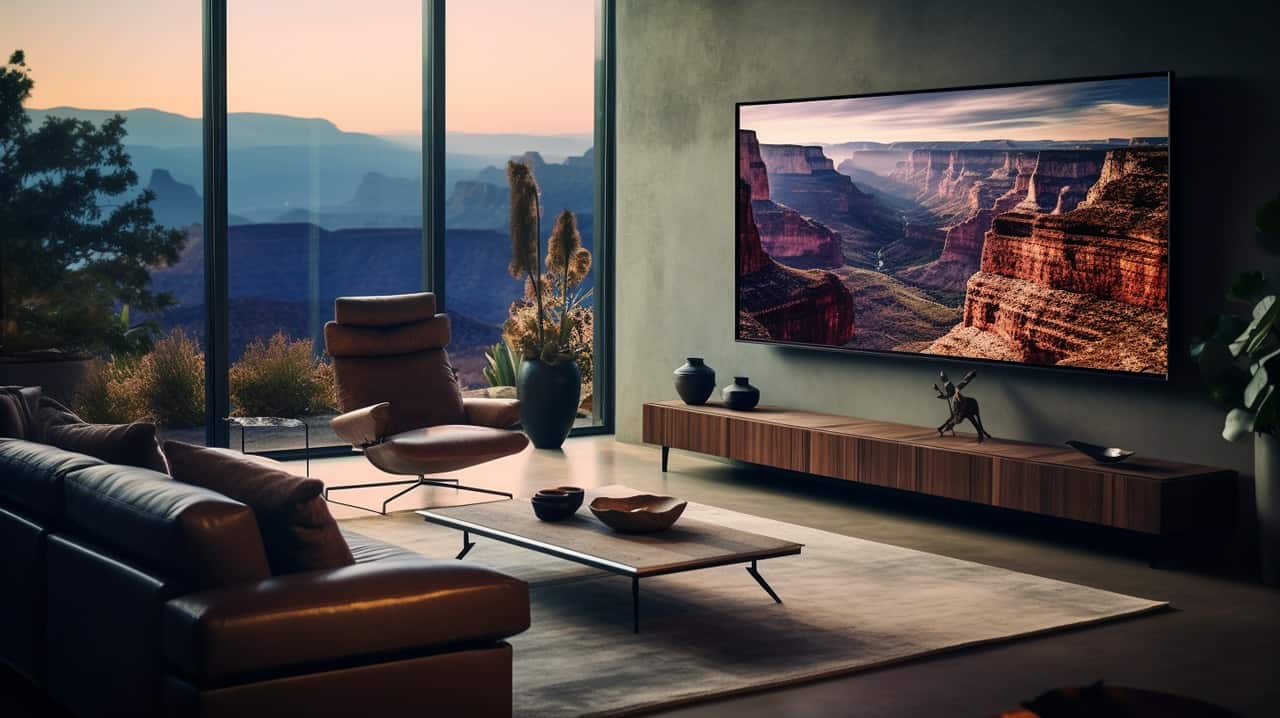Purchasing a new TV can feel like quite the thrill, but navigating through a sea of models and features can often create more confusion than clarity. If you’re nodding in agreement, don’t worry – you’re not alone! After diving deep into the realm of primetime displays and learning by doing, I have pieced together this all-inclusive guide to streamline your TV shopping journey.
From setting a realistic budget to cracking complex tech jargon, I promise to hold your hand every step of the way as we find an ideal television that matches both your needs and tastes.
So, are you ready for this enlightening expedition into the world of flat screens? Let’s dive right in!
Key Takeaways
Screen size and resolution of a TV matter. Bigger screens suit larger rooms or families. 4K resolution is the best; it makes shows look real.
Types of TVs can impact your choice. OLED TVs give better pictures but cost more than LCD or LED LCDs.
Smart TVs connect to the internet for streaming shows and movies. They also have voice control and work with smart home devices.
For gamers, a high refresh rate, like 120 Hz, is best on a TV. Low input lag allows fast responses in games.
Table of Contents
How to Determine Your Budget for a New TV
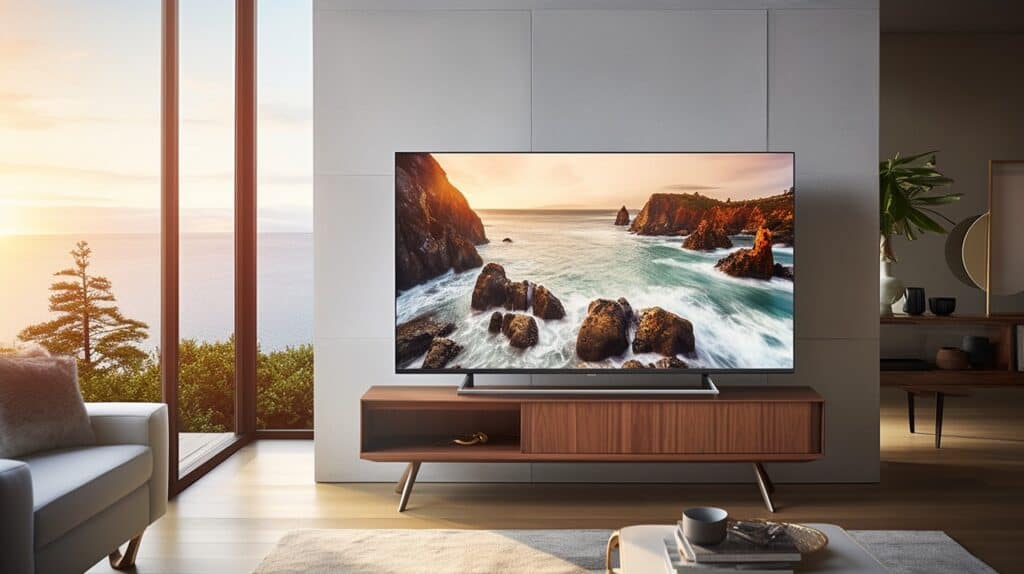
You must fix a budget before you buy a new TV. A budget helps you prevent overspending. It also helps narrow down your choices for TVs. For around $500, you can get a 55-inch 4K TV with upgraded features.
If you want to spend less, there are cheaper options, too, but the picture quality might not be as good.
8K TVs cost more than 4K TVs but don’t offer much benefit right now. The content available for these TVs is very limited at this time. Buying an expensive 8K TV may not make much sense now when the price will likely drop in the future as more becomes available.
Selecting the Right Screen Size
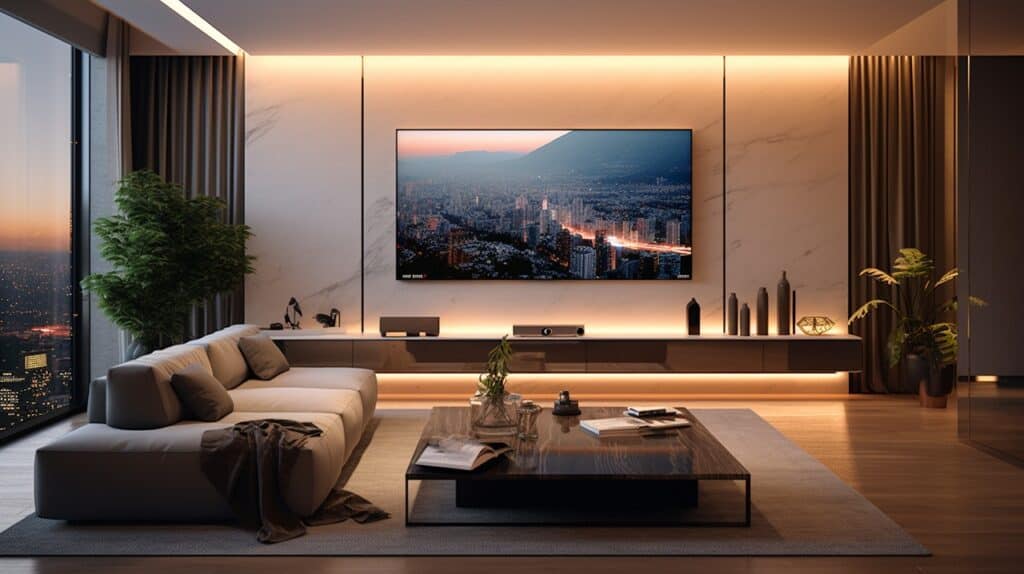
Buying a TV is not just about price or looks. The screen size matters, too. A big part of this choice comes from how much room you have for the TV. You need to figure out where in your home you will put it.
Another factor is the number of people watching at once. Will it be just you? Or do you plan on having movie nights with friends or family? More viewers mean a bigger screen size.
My advice is to think about space and viewers first before picking a screen size. For the best view, sit three times away from the height of an HD TV and half less for a 4K Ultra HD one. This way, no pixels pop up to ruin your watch time.
Another thing to consider when choosing your TV size is how you plan to mount or position it. Will you use a TV stand or entertainment center? Or are you looking to mount it on the wall? For wall mounting, be sure to select a 65 inch TV wall mount that can support the size and weight of your new television.
Most people like their TVs between 55 and 65 inches wide – big enough for clear images but not too large to fit most rooms well. But always keep in mind that each home has different needs and spaces! So, take time when choosing what works best for you.
Understanding TV Screen Resolution
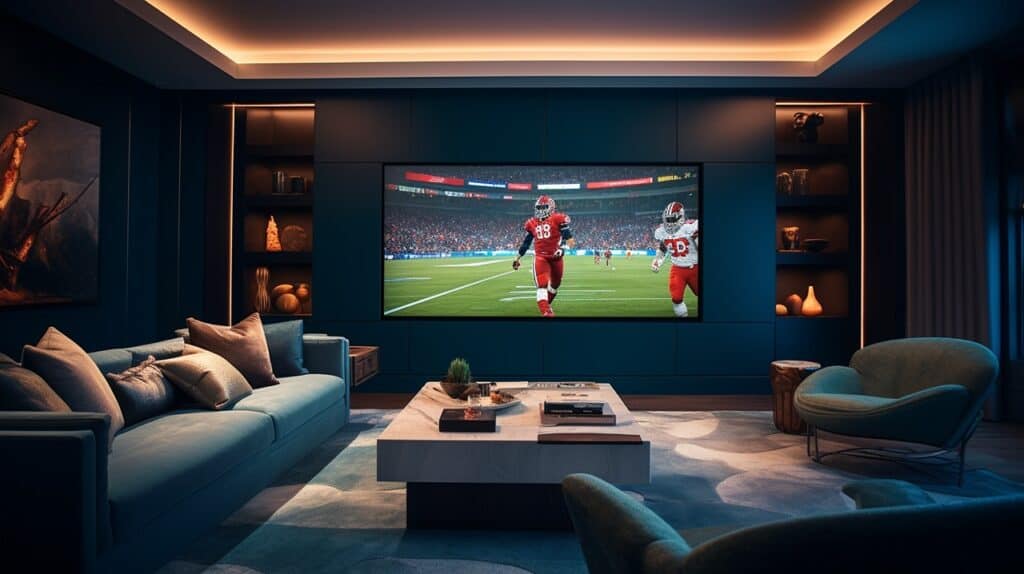
Diving into the world of TV screen resolution can be thrilling but also daunting with terms like 8K, 4K, and HD. We’ll clearly explain these intricate details to make sure you choose a television offering crisp quality images that meet your expectations.
Ready to unlock the secrets behind TV resolution? Stay tuned!
8K Resolution
8K TVs are the top dogs right now. They have four times more pixels than 4K TVs! But, they cost a lot of money, and there’s not much 8K content to watch yet. Getting an 8K TV is like having a super-fast car but no roads to drive it on.
Right now, buying a TV with at least 4K resolution is your best bet.
4K Resolution
4K is a big step up from HD. It packs in four times more pixels. That’s 6 million extra spots of color! The result? A crisper, richer picture that pulls you right into the action on your screen.
Your 1080p HD TV might be fantastic, but 4K is excellent in quality and new features alike. Not to mention that 4K is four times the quality of 1080p. The High Dynamic Range (HDR) will help colors pop, making bright colors brighter, and the dark colors darker, which helps define your viewing experience with refined quality. Plus, HDR is improving each year, with frequent software updates, and with the recurrent drop in prices, it makes the upgrade all the more worth it.
https://www.geekextreme.com/is-upgrading-to-4k-worth-it/
Even shows and movies that aren’t shot in 4K look better because this smart TV tech fills in extra detail to keep everything sharp. And it’s not just about the details here and now — think long term too! As more channels switch to shooting in 4K and streaming services like Netflix offer heaps of amazing content, investing in a 4K TV makes sure you stay ahead of the game.
HD Resolution
HD Resolution is all about clear and detailed pictures. It gives us 1920 pixels from side to side and 1080 pixels from top to bottom on the TV screen. This high pixel count is why we call it “1080p”.
HD resolution makes your shows, games, and movies look great. In today’s world, try to buy a TV with at least HD resolution for the best viewing experience.
Exploring Different TV Types
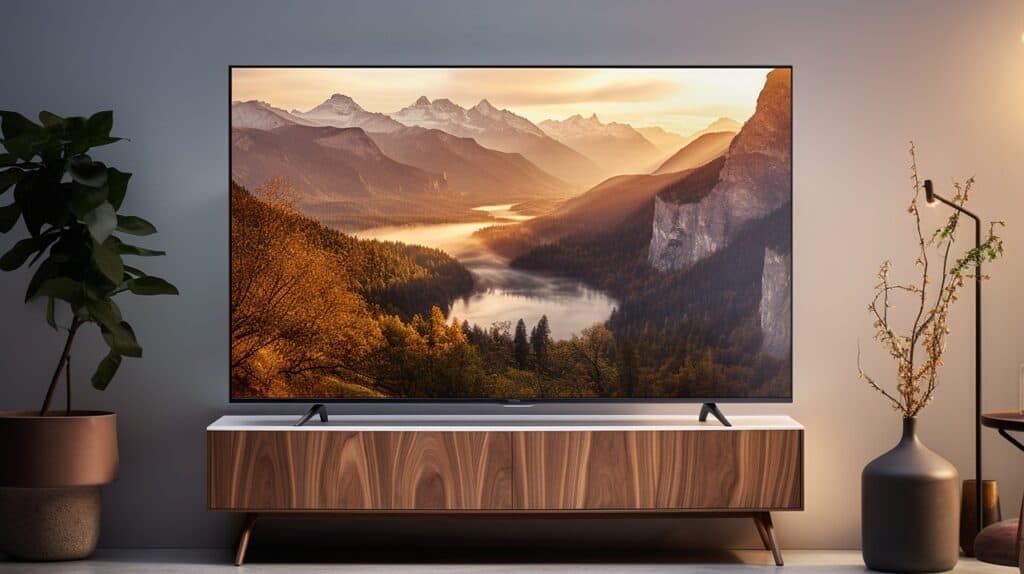
In today’s market, you’ll find a range of TV types to consider. LCD TVs offer affordable options with decent picture quality. LED LCDs enhance brightness and energy efficiency, while OLED TVs deliver superior contrast with true blacks.
Understanding each type can help you find the right fit for your viewing needs.
LCD TVs
LCD TVs are everywhere. They work by shining light on liquid crystals to make pictures on the screen. You get bright colors and clear images with these types of TVs. But they may not show deep black colors as well as other kinds of TVs, like OLEDs or QLEDs.
Still, if you are looking for a good TV at a reasonable price, an LCD TV can be a great pick!
LED LCD TVs
LED LCD TVs light your screen with tiny lights called LEDs. They can be very bright and make colors look clear. These TVs can change how bright they are in different parts of the screen.
This helps show better pictures with dark or light spots. You can get easy-to-use LED LCD sets for a low price, like $200 for a 32-inch TV.
OLED TVs
OLED TVs give you the best picture. They are better than most LCD sets. They show true black colors and good detail in shadows. These TVs are ultra-thin too, some even as thin as two credit cards stacked up! You can see a clear image from any angle, not just straight on.
So it’s great for watching with a group of people or if your couch is off to the side.
The Importance of High Dynamic Range (HDR)
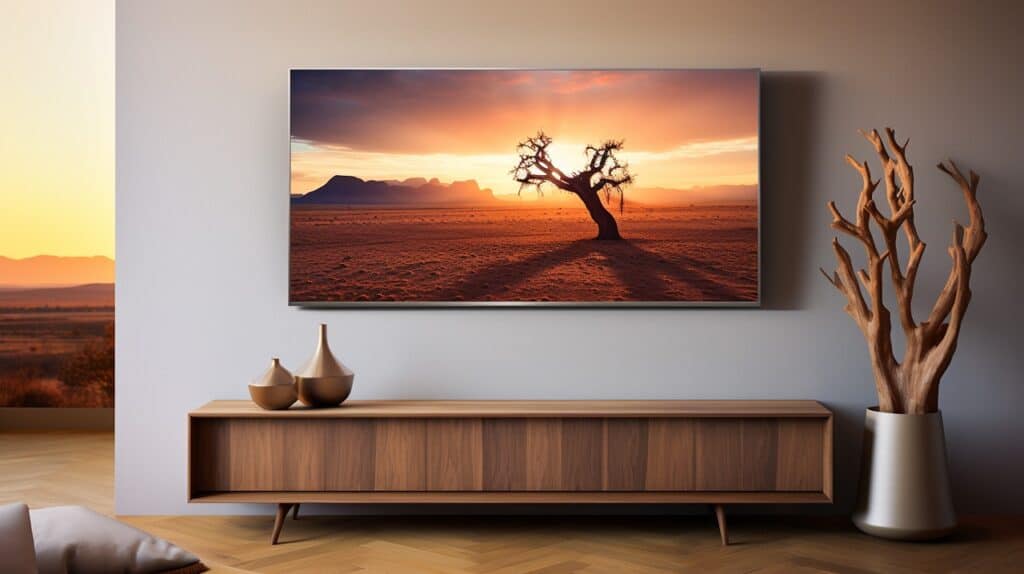
HDR technology is a game-changer in TV viewing. It makes the pictures on your screen come alive with bold, bright colors. I’ve noticed how it can bring out more depth and texture in images.
The dark parts of the picture get darker, while the bright parts become brighter. This gives me a sense of looking at real life through my TV screen! Some TVs perform better than others when it comes to HDR content.
Many HDR TVs produce only 100 to 300 nits, but top-performing ones can generate at least 600 nits for an amazing HDR experience.
The Role of Refresh Rate in TVs
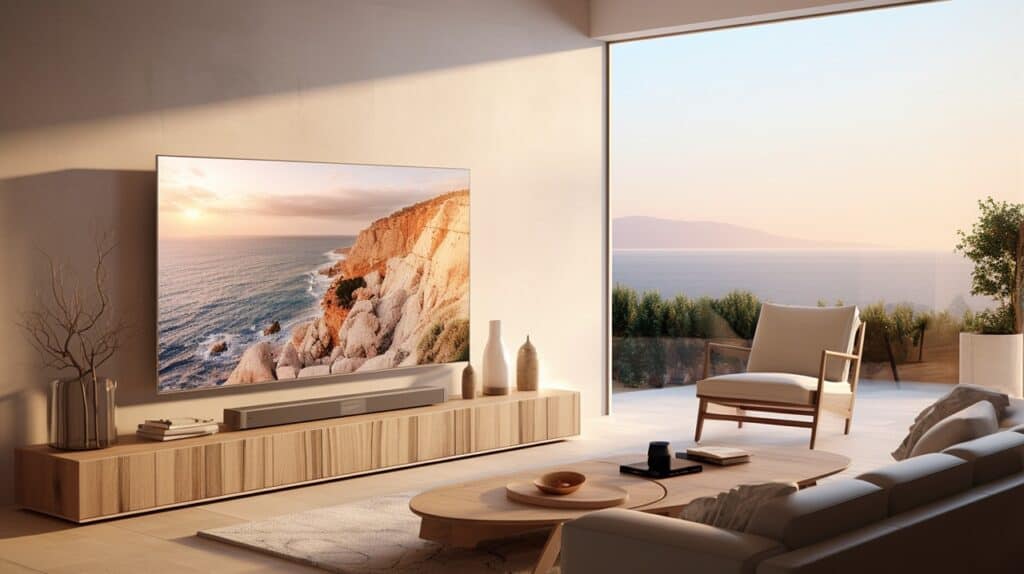
The refresh rate is very important in TVs. It tells how fast the TV changes the picture on the screen. If your TV has a high refresh rate, it will show smooth moves in movies or games.
Most people like a TV with at least a 120 Hz refresh rate.
Without a good refresh rate, you can see blurs when things move fast on the screen. This could be bad for watching sports or playing video games. So, keep an eye out for this feature when choosing your new TV!
The Necessity of HDMI and Other Connections
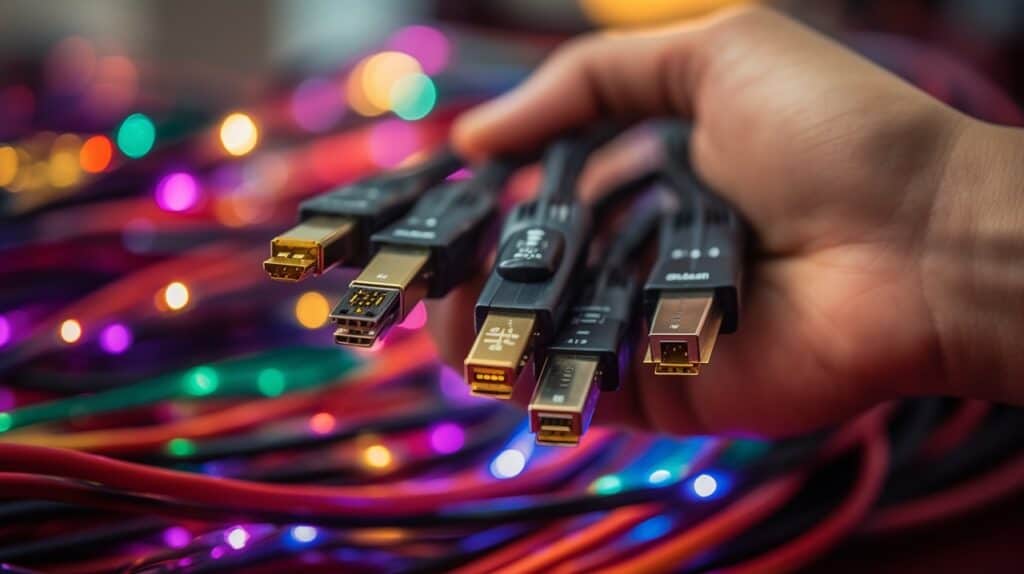
You must check the TV for HDMI and other connections before buying. It’s that important!
- Look out for at least four HDMI ports on your TV. More ports allow you to connect more devices at once.
- Go for a TV with newer HDMI 2.1 format ports if possible. They have cool features!
- The new UHD TVs come with these HDMI 2.1 inputs already.
- These inputs let you enjoy 8K video and higher frame rates, which means better picture quality.
- They also support HDR formats like Dolby Vision and HDR10+, giving colors that pop out of the screen!
- Other than HDMI, check for USB ports too.
- You might need them to plug in external drives or other accessories.
So, make sure you don’t forget about checking these connections while shopping for your new TV!
The Rise of Smart TVs
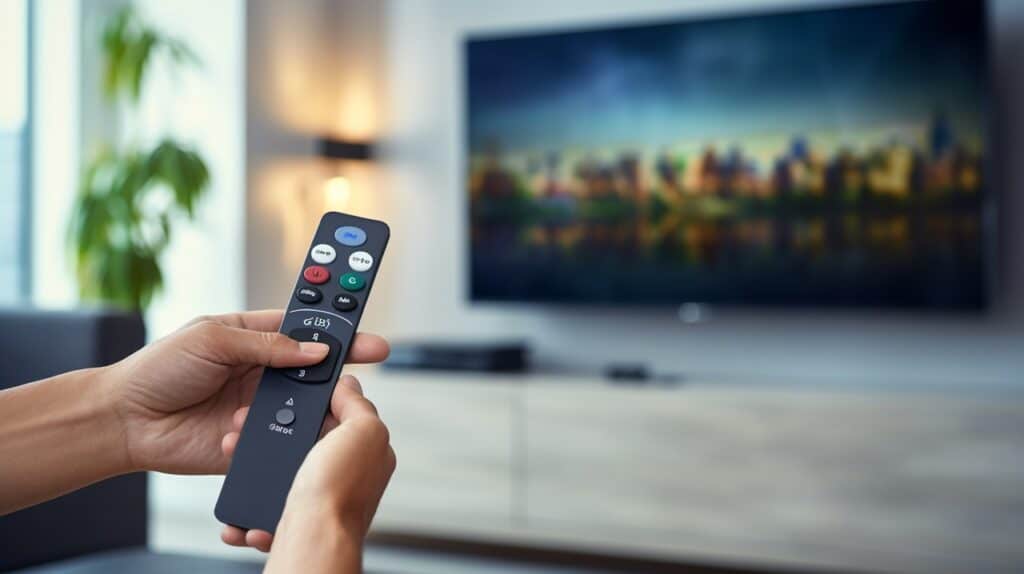
Smart TVs are taking over a big part of the TV market. They can do more than show your favorite shows. Here’s why they’re so popular:
- Smart TVs connect to the internet.
- You can stream shows and movies on smart TVs using Netflix, Prime, Hulu, YouTube, or Amazon Prime Video.
- Most US homes have at least one smart TV.
- You can use voice controls like Alexa, Siri, or Google Assistant on some smart TVs.
- If you want internet on a normal TV, you need a separate device like a Roku or Fire TV stick.
- Smart home devices work with many smart TVs for easy control of lights and other things in your house.
- Some smart TVs even help adjust the light in your room to make watching easier on your eyes!
Gaming on Your TV: What You Need to Know
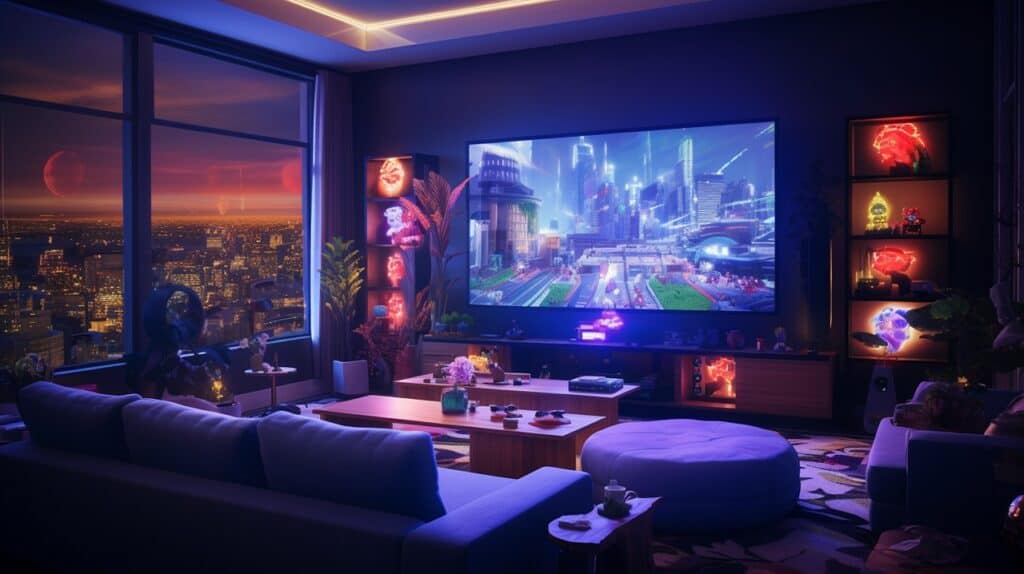
Gaming on your TV has its own quirks. You need to look for specific features in a TV meant for gaming. A high refresh rate is key here, like 120 Hz. Refresh rates tell you how many times the image changes each second.
TVs with higher refresh rates show fast action games more smoothly.
Another feature to check is input lag time. Low input lag means faster response when you press buttons on your controller and see the action happen on screen.
Next up, HDMI ports are vital, too, if you use consoles for gaming. Four HDMI ports should be enough, but having more doesn’t hurt either.
Lastly, if you’re into serious gaming, consider a TV boasting Auto-Low Latency Mode (ALLM) or Variable Refresh Rate (VRR). These make sure your game visuals keep pace with your console’s output without tearing or stuttering.
So there it is! Although all these might sound technical, they aren’t hard to understand and can enhance your overall gaming experience significantly.
Decoding TV Jargon: Contrast Ratio
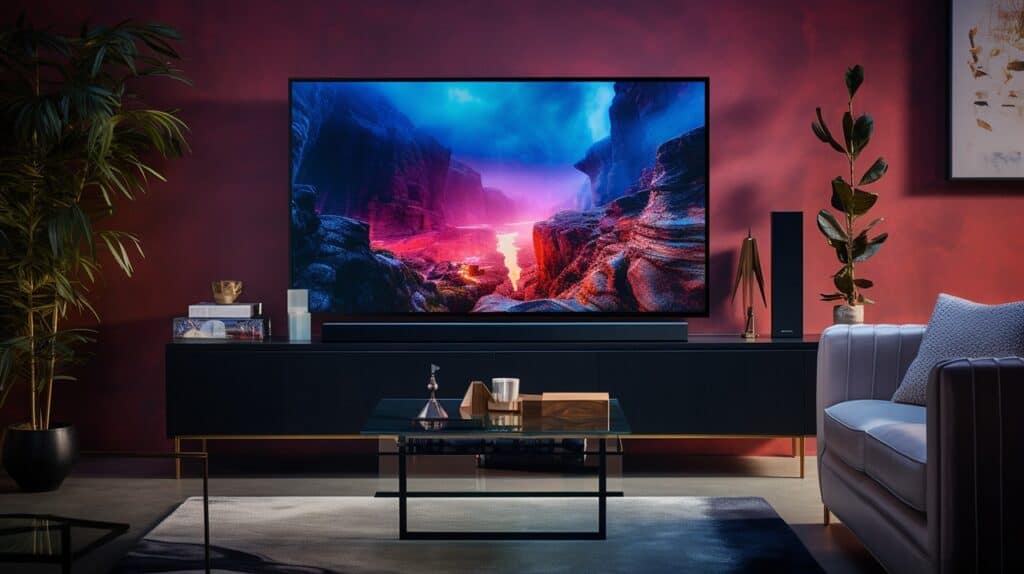
Let’s talk about the contrast ratio next. It is a key feature you should look at while buying a TV. The higher the contrast ratio, the better your TV will be at showing both light and dark parts on screen.
So what does this mean? Say a TV has a contrast ratio of 1000:1; it can show whites that are 1000 times brighter than its blacks. This helps make pictures pop out more.
OLED TVs win here as they have high contrast ratios when compared to LCD sets. HDR technology also lifts the quality of the picture by improving this factor even more. A good HDR set makes colors seem real, which makes us feel like we are inside the movie or game we are playing!
Why You Should Consider Buying a Soundbar
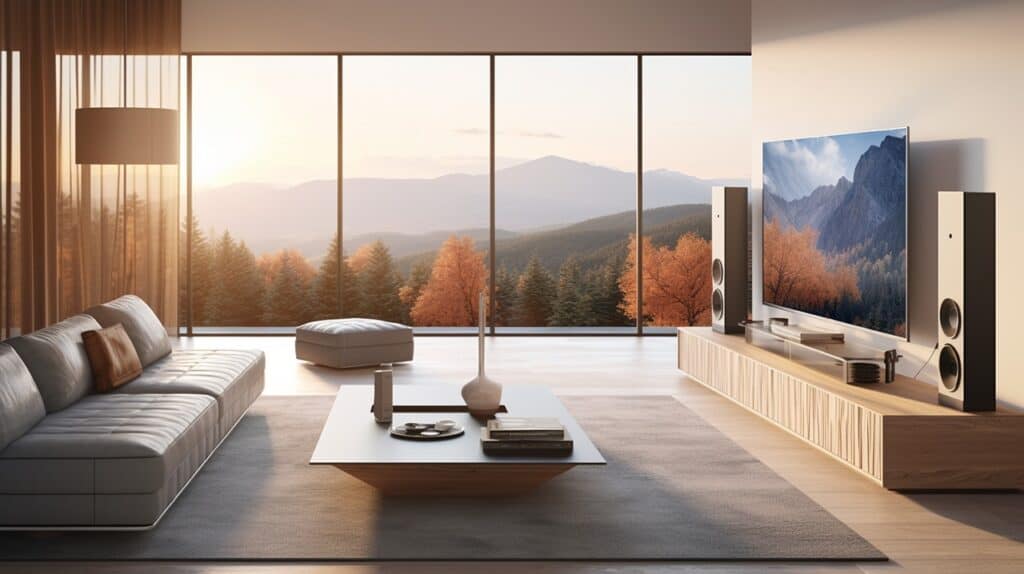
Soundbars are a good choice if you want better sound from your TV. Here are some reasons to consider buying one:
- The speakers on TVs today don’t give great sound.
- Soundbars can make the sound from your TV a lot better.
- They offer more clear and deep sounds than built-in TV speakers do.
- You get more surround sound effects with a soundbar.
- As TVs get more advanced, so do soundbars. They have become key gear for top-notch viewing at home.
- A big perk of getting a soundbar is it makes you feel like you’re in the movie or game. It makes everything seem real!
Dispelling Myths About Extended Warranties
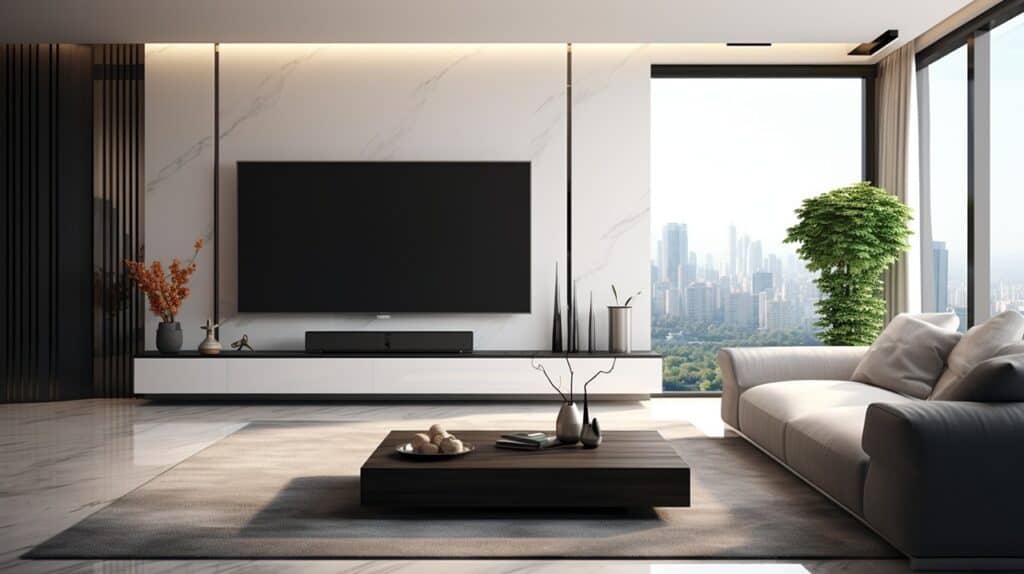
A lot of people think they need to buy an extended warranty for their new TV. That’s a myth! Most TVs don’t break during the time that the extended warranty covers. Plus, if your TV does have issues, often it’s cheaper to fix it than to buy a warranty.
Another fact is credit card companies might cover your purchase. They can protect you if something goes wrong with your TV.
You also might hear that the store or brand’s warranty isn’t good. That’s not always true. You should read what the store or brand offers before buying extra coverage. In many cases, their guarantee may be just as good or even better than an extended one you’d pay more for.
How to Find the Best Deals on TVs
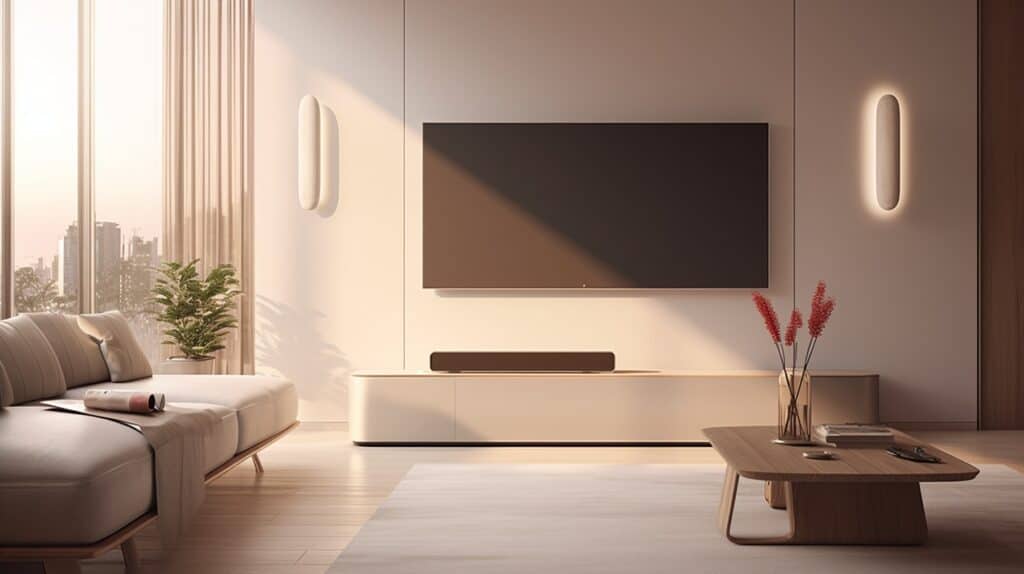
I always use these tips to save money when buying a new TV.
- Plan for big sales: Many stores have their biggest sales in November and December.
- Compare prices: Use online sites like Amazon, Best Buy, and Walmart to see who has the best price.
- Check out Tom’s Guide: This site gives reviews on many TVs. They tell you the good parts and bad parts of each model they review.
- Look at older models: Often, last year’s model will be much cheaper than this year’s model.
- Ask about open-box deals: These are TVs that were brought back to the store but work just fine.
- Think about refurbished TVs: These are used TVs that have been fixed up by the manufacturer or store, so they work like new again.
- Sign up for store emails or alerts: You can get news about upcoming sales sent right to your email!
- Take advantage of price matches: If one store offers a lower price than another, some stores will match it, so you still buy from them instead!
- Build relationships with shop staff members; They may inform you ahead of future discounts based on your interests.
By using these tips, I’m sure you’ll find an excellent deal on your next TV purchase!
Step-by-Step Guide to Buying a TV
Firstly, set a budget you’re comfortable with for your new TV purchase. Then, decide on the ideal screen size based on where it will be placed in your home or office. Do some research to determine if OLED or LED would best suit your needs and preferences.
Next, select the resolution that fits within your budget – 8K, 4K, or HD. Consider whether having smart TV features such as built-in streaming apps and voice-enabled digital assistants is important to you.
Check that the television has sufficient HDMI ports and other necessary connections for all of your devices. Think about investing in enhanced audio, like soundbars, to improve viewing quality even further.
The remote control shouldn’t be a deal-breaker; most are universal now and can fit any brand of TV just fine. Lastly, consider warranty options carefully, ensuring they offer good value for money rather than simply inflating the total price.
Decide on your budget
Deciding on your budget is a key step in buying a TV. You need to know how much you can spend. A good 55-inch 4K TV with better features can cost around $500. Don’t rush to buy an expensive 8K TV right now.
There’s not a lot of stuff to watch in 8K yet, so it may not be worth the extra money at this time.
Choose the right TV size for your space
Finding the perfect TV size for your room is key. A useful tip to remember: the distance between you and your TV should be double the screen size. So, if you own a 50-inch TV, sit about 100 inches away.
That’s about eight feet. If you have less space, get a smaller TV. For bigger rooms, larger TVs are great! But don’t go too big or close – that may hurt your eyes. The best thing to do? Measure your room first – then pick a screen size!
Decide between OLED and LED
You need to pick between OLED and LED. Both have good points. OLED TVs give the best picture. Every pixel in an OLED screen can light up or turn off on its own. This means you get real blacks when the TV shows a dark scene because those pixels can turn completely off.
LED TVs are not as pricey as OLED ones though, but they still bring color and depth to your screen. They work with a light source behind the panel, which lights up the colors on your screen.
Some top-of-the-line LED TVs use quantum dots for better color accuracy, too! So, if budget is key, you might go for an LED TV instead of an OLED one.
Choose your desired TV resolution
You need to pick the right TV resolution. High-resolution TVs show better pictures. The picture is clear and sharp. A 4K TV is a good choice. This type of TV shows four times more detail than regular HD TVs! But, you will pay more for it.
There are also 8K TVs with an even better picture. But they cost a lot and there is not much to watch in 8K yet. So, a 4K TV can be the best for now.
Consider the benefits of a smart TV
A smart TV makes watching shows and movies easy. It brings Netflix, Prime, Hulu, YouTube, and Amazon Prime Video all in one place. There is no need to switch devices or inputs. Plus, you can use a wired connection for better streaming quality.
Another cool part? If you want some quiet time with your favorite show, just connect a pair of wireless headphones via Bluetooth!
Ensure your chosen TV has the necessary connections
It’s important to buy a TV with many HDMI ports. These are where you plug in things like game systems, Blu-ray players, or soundbars. Try to get a TV with at least four of them! High-quality HDMI cables can help make the picture and sound better, too.
You might want a TV that has Bluetooth as well. This lets you use wireless headphones for private listening. If you love streaming shows, go for hard-wiring your TV to the network with an Ethernet cable.
It helps avoid issues while watching your favorite series on Netflix or Prime!
Consider investing in enhanced audio
Good sound is key to enjoying your new TV. Many TVs come with basic speakers. These can do the trick, but you might not get full, rich sound. Think about getting a soundbar or better speakers for your TV.
A good audio system brings movies and shows to life. It makes music sound great, too! Investing in enhanced audio will give you a top-notch home theater experience. Don’t just look at the picture quality when buying a new TV; also consider how it sounds!
Don’t get hung up on the remote control
A TV remote is just a tiny part of the buying process. You might not like the buttons on one, but that’s okay. Don’t let it stop you from getting that TV. Many TVs now use voice control or have apps you can use.
Using your phone to switch channels is easy! Making too big a deal out of the remote could mean missing out on a great TV!
Think carefully about the warranty
Buying a new TV is a big deal. One key thing to look at is the warranty that comes with it. A good warranty can save you money and stress down the line. Make sure you buy your TV from an authorized dealer like World Wide Stereo.
This ensures you get the full manufacturer’s warranty plus extra support from the dealer if needed. You don’t want to be stuck with a broken TV and no help lined up! So take time, read through what the warranty covers, ask questions if you need to, and just ensure you’re protected in case of any issues.
FAQs About How to Buy a TV
What is the meaning of TV resolution, and why is it important?
TV resolution means the sharpness of the picture on a TV screen. It can be 1080p, 4K, or 8K. Higher numbers mean better details and more clear images.
How does the refresh rate impact my TV viewing experience?
The refresh rate stands for how many times your TV updates with new pictures each second. TVs with higher rates, like 120Hz or 240Hz, can offer smoother motion scenes.
What are Smart TVs, and which brands should I consider?
Smart TVs can connect to internet services and have apps like Roku, Android TV, and Fire TV from top brands such as LG, Sony, Samsung, Hisense, or Vizio.
What’s the difference between LCD, LED, OLED, and QLED TVs?
These terms refer to different types of display technology used in TVs. LED TVs use light-emitting diodes, while OLEDs use organic compounds that light up when electricity passes through them. QLEDs use quantum dots for brighter colors.
What additional features should I look for in gaming-focused televisions?
For gaming purposes, consider high contrast ratio TVs; those having high frame rate (HFR) support along with Active dimming or local dimming features offering clearer visuals during fast-paced games.
Can my television do more apart from just watching shows?
Yes! Some smart TVs also work as hubs for smart home devices – they connect to Amazon Alexa or Apple Siri, allowing control over lights and thermostats right from your couch.

